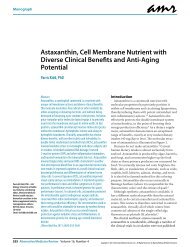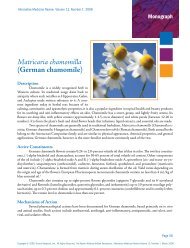Picrorhiza kurroa Monograph - Alternative Medicine Review
Picrorhiza kurroa Monograph - Alternative Medicine Review
Picrorhiza kurroa Monograph - Alternative Medicine Review
You also want an ePaper? Increase the reach of your titles
YUMPU automatically turns print PDFs into web optimized ePapers that Google loves.
<strong>Picrorhiza</strong> <strong>kurroa</strong>KutkinCHCHOCOCH 2 OHCOHOOH 3O<strong>Monograph</strong><strong>Picrorhiza</strong> <strong>kurroa</strong>Introduction<strong>Picrorhiza</strong> <strong>kurroa</strong> is a well-known herb in the Ayurvedic system of medicine and has traditionallybeen used to treat disorders of the liver and upper respiratory tract, reduce fevers, and to treatdyspepsia, chronic diarrhea, and scorpion sting. It is a small perennial herb from the Scrophulariaceaefamily, found in the Himalayan region growing at elevations of 3,000-5,000 meters. <strong>Picrorhiza</strong> <strong>kurroa</strong>has a long, creeping rootstock that is bitter in taste, and grows in rock crevices and moist, sandy soil.The leaves of the plant are flat, oval, and sharply serrated. The flowers, which appear June throughAugust, are white or pale purple and borne on a tall spike; manual harvesting of the plant takes placeOctober through December. The active constituents are obtained from the root and rhizomes. The plantis self-regenerating but unregulated over-harvesting has caused it to be threatened to near extinction.Current research on <strong>Picrorhiza</strong> <strong>kurroa</strong> has focused on its hepatoprotective, anticholestatic, antioxidant,and immune-modulating activity. 1,2Active ConstituentsKutkin is the active principal of <strong>Picrorhiza</strong> <strong>kurroa</strong> and is comprised of kutkoside and the iridoidglycoside picrosides I, II, and III. Other identified active constituents are apocynin, drosin, and ninecucurbitacin glycosides. 3,4 Apocynin is a catechol that has been shown to inhibit neutrophil oxidativeburst in addition to being a powerful anti-inflammatory agent, 5 while the curcubitacins have been shownto be highly cytotoxic and possess antitumor effects. 6Mechanisms of ActionThe hepatoprotective action of <strong>Picrorhiza</strong> <strong>kurroa</strong> is not fully understood but may be attributedto <strong>Picrorhiza</strong>’s ability to inhibit the generation of oxygen anions and to scavenge free radicals. 7<strong>Picrorhiza</strong>’s antioxidant effect has been shown to be similar to that of superoxide dismutase, metal-ionchelators, and xanthine oxidase inhibitors. 8 In rats infected with malaria, <strong>Picrorhiza</strong> restored depletedglutathione levels, thereby enhancing detoxification and antioxidation, and helping maintain a normaloxidation-reduction balance. 9 In this same animal model, <strong>Picrorhiza</strong> also demonstrated an anti-lipidperoxidative effect. 10 Like silymarin, <strong>Picrorhiza</strong> has been shown to stimulate liver regeneration in rats,possibly via stimulation of nucleic acid and protein synthesis. 11 <strong>Picrorhiza</strong>’s anti-inflammatory actionis attributed to the apocynin constituent, which has been shown to have potent anti-inflammatory propertiesin addition to inhibiting oxidative burst in neutrophils. 5 Although the mechanism is unclear,<strong>Alternative</strong> <strong>Medicine</strong> <strong>Review</strong> ◆ Volume 6, Number 3 ◆ 2001 Page 319Copyright©2001 Thorne Research, Inc. All Rights Reserved. No Reprint Without Written PermissionOOHCH 2 OHOHOH+ 2H 2 O
animal studies indicate <strong>Picrorhiza</strong>’s constituents exhibit a strong anticholestatic activity against a varietyof liver-toxic substances, appearing to be even more potent than silymarin. <strong>Picrorhiza</strong> also exhibitsa dose-dependent choleretic activity, evidenced by an increase in bile salts and acids, and bile flow. 12Clinical IndicationsHepatic Insult and DamageNumerous animal studies, primarily in rats, have demonstrated that the active constituents of<strong>Picrorhiza</strong> <strong>kurroa</strong> are effective at preventing liver toxicity and the subsequent biochemical changescaused by numerous toxic agents. Hepatocytes damaged by exposure to galactosamine, thiocetamide,and carbon tetrachloride were incubated with <strong>Picrorhiza</strong> constituents. A concentration-dependent restorativeeffect was observed in regard to normal hepatocyte function. 13 A similar effect was seen when25 mg/kg/day oral <strong>Picrorhiza</strong> extract was administered to rats poisoned by aflatoxin B1 exposure.<strong>Picrorhiza</strong> <strong>kurroa</strong> significantly prevented the biochemical changes induced by aflatoxin B1. 14 <strong>Picrorhiza</strong>extract, when given at a dose of 3-12 mg/kg orally for 45 days, was also shown to be effective inreversing ethanol-induced liver damage in rats. 15 In an animal model of hepatic ischemia, rats given<strong>Picrorhiza</strong> orally at 12 mg/kg daily for 7 days, prior to induced ischemia, demonstrated improvedhepatocyte glycogen preservation and reduced apoptosis, compared to control animals. 16 <strong>Picrorhiza</strong>principals have also shown to be effective in treating Amanita mushroom poisoning in an in vivo animalmodel. 17 An in vitro study demonstrated <strong>Picrorhiza</strong>’s antioxidant activity by subjecting human Gliomaand Hep 3B cells to a hypoxic state. <strong>Picrorhiza</strong> treatment reduced the cellular damage cause by hypoxia,indicating <strong>Picrorhiza</strong> constituents may protect against hypoxia/reoxygenation-induced injuries. 18Viral HepatitisStudies indicate <strong>Picrorhiza</strong> extracts may be of therapeutic value in treating viral hepatitis. An invitro study investigated anti-hepatitis B-like activity of <strong>Picrorhiza</strong> and found it to have promising antihepatitisB surface antigen activity. 19 In a randomized, double-blind, placebo-controlled trial of 33patients diagnosed with acute viral hepatitis, 375 mg <strong>Picrorhiza</strong> root powder was given three timesdaily for two weeks. The treatment group was comprised of 15 patients; the remaining 18 subjectsacted as controls and received placebo. Bilirubin, SGOT, and SGPT values were significantly lower inthe treatment group, and the time required for bilirubin values to drop to 2.5 mg% was 27.4 days in thetreatment group versus 75.9 days for the placebo group. 20Asthma/AllergyIn vivo studies of bronchial obstruction indicate that the drosin constituent of <strong>Picrorhiza</strong> <strong>kurroa</strong>prevented allergen- and platelet activating factor-induced bronchial obstruction when given to guineapigs via inhalant and oral routes. In vitro histamine release was also inhibited by the plant extract. 21<strong>Picrorhiza</strong> extract given orally at 25 mg/kg to mice and rats resulted in a concentration-dependentdecrease in mast cell degranulation. However, induced bronchospasm was not prevented, indicating alack of direct post-synaptic histamine receptor blocking activity. 22Dosage and Toxicity<strong>Picrorhiza</strong> is not readily water-soluble and is therefore not usually taken as a tea. While it isethanol soluble, the bitter taste makes tinctures unpalatable, so it is therefore usually administered as astandardized (4% kutkin) encapsulated powder extract. Typical adult dosage is 400 to 1500 mg/day,with dosages up to 3.5 g/day sometimes being recommended for fevers. <strong>Picrorhiza</strong> root extracts arePage 320 <strong>Alternative</strong> <strong>Medicine</strong> <strong>Review</strong> ◆ Volume 6, Number 3 ◆ 2001Copyright©2001 Thorne Research, Inc. All Rights Reserved. No Reprint Without Written Permission
<strong>Picrorhiza</strong> <strong>kurroa</strong>widely used in India with no adverse effects having been reported. The LD 50of kutkin is greater than2600 mg/kg in rats with no data available for humans. 23References1. Atal CK, Sharma ML, Kaul A, Khajuria A. Immunomodulating agents of plant origin. I: preliminary screening. JEthnopharmacol 1986;18:133-141.2. Subedi BP. Plant profile: Kutki (<strong>Picrorhiza</strong> scrophulariiflora). Himalayan Bioresources 2000;4.3. Weinges K, Kloss P, Henkels WD. Natural products from medicinal plants. XVII. picroside-II, a new 6-vanilloylcatapolfrom <strong>Picrorhiza</strong> kuroa Royle and Benth. Justus Liebigs Ann Chem 1972;759:173-182. [Article in German]4. Stuppner H, Wagner H. New cucurbitacin glycosides from <strong>Picrorhiza</strong> <strong>kurroa</strong>. Planta Med 1989;55:559-563.5. Simons JM, ‘t Hart BA, Ip Vai Ching TR, et al. Metabolic activation of natural phenols into selective oxidativeburst agonists by activated human neutrophils. Free Radic Biol Med 1990;8:251-258.6. Stuppner H, Wagner H. New cucurbitacin glycosides from <strong>Picrorhiza</strong> <strong>kurroa</strong>. Planta Medica 1989;55:559.7. Russo A, Izzo AA, Cardile V, et al. Indian medicinal plants as antiradicals and DNA cleavage protectors.Phytomedicine 2001;8:125-132.8. Chander R, Kapoor NK, Dhawan BN. Picroliv, picroside-I and kutkoside from <strong>Picrorhiza</strong> <strong>kurroa</strong> are scavengersof superoxide anions. Biochem Pharmacol 1992;44:180-183.9. Chander R, Kapoor NK, Dhawan BN. Effect of picroliv on glutathione metabolism in liver and brain of Mastomysnatalensis infected with Plasmodium berghei. Indian J Exp Biol 1992;30:711-714.10. Chander R, Singh K, Visen PK, et al. Picroliv prevents oxidation in serum lipoprotein lipids of Mastomys couchainfected with Plasmodium berghei. Indian J Exp Biol 1998;36:371-374.11. Singh V, Kapoor NK, Dhawan BN. Effect of picroliv on protein and nucleic acid synthesis. Indian J Exp Biol1992;30:68-69.12. Shukla B, Visen PK, Patnaik GK, et al. Choleretic effect of picroliv, the hepatoprotective principle of <strong>Picrorhiza</strong><strong>kurroa</strong>. Planta Med 1991;57:29-33.13. Visen PK, Saraswat B, Dhawan BN. Curative effect of picroliv on primary cultured rat hepatocytes againstdifferent hepatotoxins: an in vitro study. J Pharmacol Toxicol Methods 1998;40:173-179.14. Rastogi R, Srivastava AK, Rastogi AK. Biochemical changes induced in liver and serum aflatoxin B1-treated malewistar rats: preventive effect of picroliv. Pharmacol Toxicol 2001;88:53-58.15. Saraswat B, Visen PK, Patnaik GK, Dhawan BN. Ex vivo and in vivo investigations of picroliv from <strong>Picrorhiza</strong><strong>kurroa</strong> in an alcohol intoxication model in rats. J Ethnopharmacol 1999;66:263-269.16. Singh AK, Mani H, Seth P. Picroliv preconditioning protects the rat liver against ischemia-reperfusion injury. EurJ Pharmacol 2000;395:229-239.17. Dwivedi Y, Rastogi R, Garg NK, et al. Effects of picroliv, the active principle of <strong>Picrorhiza</strong> <strong>kurroa</strong>, on biochemicalchanges in rat liver poisoned by Amanita phalloides. Chung Kuo Yao Li Hsueh Pao 1992;13:197-200.18. Gaddipati JP, Madhavan S, Sidhu GS, et al. Picroliv – a natural product protects cells and regulates the geneexpression during hypoxia/reoxygenation. Mol Cell Biochem 1999;194:271-281.19. Mehrotra R, Rawat S, Kulshreshtha DK, et al. In vitro studies on the effect of certain natural products againsthepatitis B virus. Indian J Med Res 1990;92:133-138.20. Vaidya AB, Antarkar DS, Doshi JC, et al. <strong>Picrorhiza</strong> <strong>kurroa</strong> (Kutaki) Royle ex Benth as a hepatoprotective agent –experimental and clinical studies. J Postgrad Med 1996;42:105-108.21. Dorsch W, Wagner H. New antiasthmatic drugs from traditional medicine? Int Arch Allergy Appl Immunol1991;94:262-265.22. Baruah CC, Gupta PP, Nath A, et al. Anti-allergic and anti-anaphylactic activity of picroliv – a standardised iridoidglycoside fraction of <strong>Picrorhiza</strong> <strong>kurroa</strong>. Pharmacol Res 1998;38:487-492.23. Annual Report, Regional Research Laboratory, Council for Scientific and Industrial Research, India. 1989-1990.<strong>Alternative</strong> <strong>Medicine</strong> <strong>Review</strong> ◆ Volume 6, Number 3 ◆ 2001 Page 321Copyright©2001 Thorne Research, Inc. All Rights Reserved. No Reprint Without Written Permission







